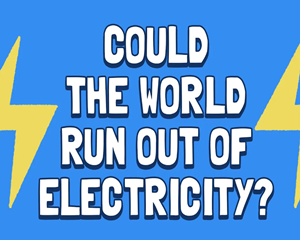You flip a switch. Coal burns in a furnace, which turns water into steam.
你拨动开关,炉中燃烧的煤将水变成蒸汽。
That steam spins a turbine, which activates a generator, which pushes electrons through the wire.
蒸汽推动涡轮并带动发动机,推动电子通过导线形成电流。
This current propagates through hundreds of miles of electric cables and arrives at your home.
电流通过数百英里电缆的传送,并到达你家。
All around the world, countless people are doing this every second -- flipping a switch, plugging in, pressing an "on" button.
全球每一秒都有无数人在做这件事--拨动开关,插电并按下“开”按钮。
So how much electricity does humanity need?
那么人类需要多少电力呢?
The amount we collectively use is changing fast,
我们共同使用的电量正快速变化,
so to answer this question, we need to know not just how much the world uses today, but how much we'll use in the future.
所以要回答这个问题,我们不仅需要知道目前全球用电多少,还要知道将来会使用多少。
The first step is understanding how we measure electricity. It's a little bit tricky.
第一步是了解我们如何测量电力,这有点棘手。
A joule is a unit of energy, but we usually don't measure electricity in just joules. Instead, we measure it in watts.
焦耳是能量单位,但通常不只用焦耳来衡量电,而是用瓦特来衡量它。
Watts tell us how much energy, per second, it takes to power something. One joule per second equals one watt.
瓦特是某物每秒所需电量,1焦耳/秒=1瓦特。
It takes about .1 watts to power a smart phone, a thousand to power your house, a million for a small town, and a billion for a mid-size city.
智能手机供电大约需要0.1瓦,你的房子供电需1千瓦,小镇供电需要100万瓦,一个中等城市需要10亿瓦。
As of 2020, it takes 3 trillion watts to power the entire world. But almost a billion people don't have access to reliable electricity.
到2020年,全球需要3万亿瓦供电,但近10亿人无法获得可靠的电力。
As countries become more industrialized and more people join the grid, electricity demand is expected to increase about 80% by 2050.
随着国家越来越工业化,越来越多的人加入电网,预计到2050年电力需求将增加约80%。
That number isn't the complete picture. We'll also have to use electricity in completely new ways.
这个数据并不完整,我们还必须以全新方式使用电力。
Right now, we power a lot of things by burning fossil fuels, emitting an unsustainable amount of greenhouse gases that contribute to global warming.
现在,我们通过燃烧化石燃料为很多东西提供动力,排放不可持续的温室气体,导致全球变暖。

We'll have to eliminate these emissions entirely to ensure a sustainable future for humanity.
我们必须完全消除这些排放,以确保人类的可持续未来。
The first step to doing so, for many industries, is to switch from fossil fuels to electric power.
对于许多行业来说,实现目标的第一步是由化石燃料转向电力。
We'll need to electrify cars, switch buildings heated by natural gas furnaces to electric heat pumps,
我们需要汽车电气化、将天然气炉供热的建筑转换为使用电热泵,
and electrify the huge amount of heat used in industrial processes.
并用电来满足工业过程中使用的大量热量。
So all told, global electricity needs could triple by 2050.
总而言之,到2050年,全球电力需求可能增加2倍。
We'll also need all that electricity to come from clean energy sources if it's going to solve the problems caused by fossil fuels.
若要解决化石燃料引起的问题,所有电力都必须来自清洁能源。
Today, only one third of the electricity we generate comes from clean sources.
今天,我们的电力中只有1/3来自清洁能源。
Fossil fuels are cheap and convenient, easy to ship, and easy to turn into electricity on demand. So how can we close the gap?
化石燃料便宜又方便,易于运输,并且很容易按需转化为电能。那么如何弥补差距呢?
Wind and solar power work great for places with lots of wind and sunshine, but we can't store and ship sunlight or wind the way we can transport oil.
风能和太阳能非常适合风和阳光充足的地方,但无法像运输石油那样储存和运输阳光或风力。
To make full use of energy from these sources at other times or in other places,
为了在其他时间或其他地方充分利用这些来源的能源,
we'd have to store it in batteries and improve our power grid infrastructure to transport it long distances.
我们必须把它储存在电池里,并改善我们的电网基础设施,以实现长距离传输。
Meanwhile, nuclear power plants use nuclear fission to generate carbon-free electricity.
同时,核电站利用核裂变产生无碳电力。
Though still more expensive than plants that burn fossil fuels,
虽然仍比燃烧化石燃料的电厂昂贵,
they can be built anywhere and don't depend on intermittent energy sources like the sun or wind.
但它们可以建在任何地方,并且不需依赖像太阳或风这样的间歇性能源。
Researchers are currently working to improve nuclear waste disposal and the safety of nuclear plants.
研究人员正努力改善核废料处理以及核电站的安全。
There's another possibility we've been trying to crack since the 1940s: nuclear fusion.
自20世纪40年代起,我们一直试图破解另一种可能性:核聚变。
It involves smashing light atoms together, so they fuse, and harnessing the energy this releases.
原理是让轻原子相撞后融合在一起,然后利用融合释放的能量。
Accidents aren't a concern with nuclear fusion, and it doesn't produce the long-lived radioactive waste fission does.
核聚变无事故之忧,也不会像核裂变那样产生长寿命放射性废物。
It also doesn't have the transport concerns associated with wind, solar, and other renewable energy sources.
它也没有运输难题,不像风能、太阳能及其他可再生能源那样。
A major breakthrough here could revolutionize clean energy. The same is true of nuclear fission, solar, and wind.
这方面的重大突破可能会彻底改变清洁能源。核裂变、太阳能和风能也是如此。
Breakthroughs in any of these technologies, and especially in all of them together, can change the world:
任何这些技术的突破,尤其是所有这些方面的突破,就能改变世界:
not only helping us triple our electricity supply, but enabling us to sustain it.
不仅帮我们实现3倍电力供应,而且使我们能维持下去。












